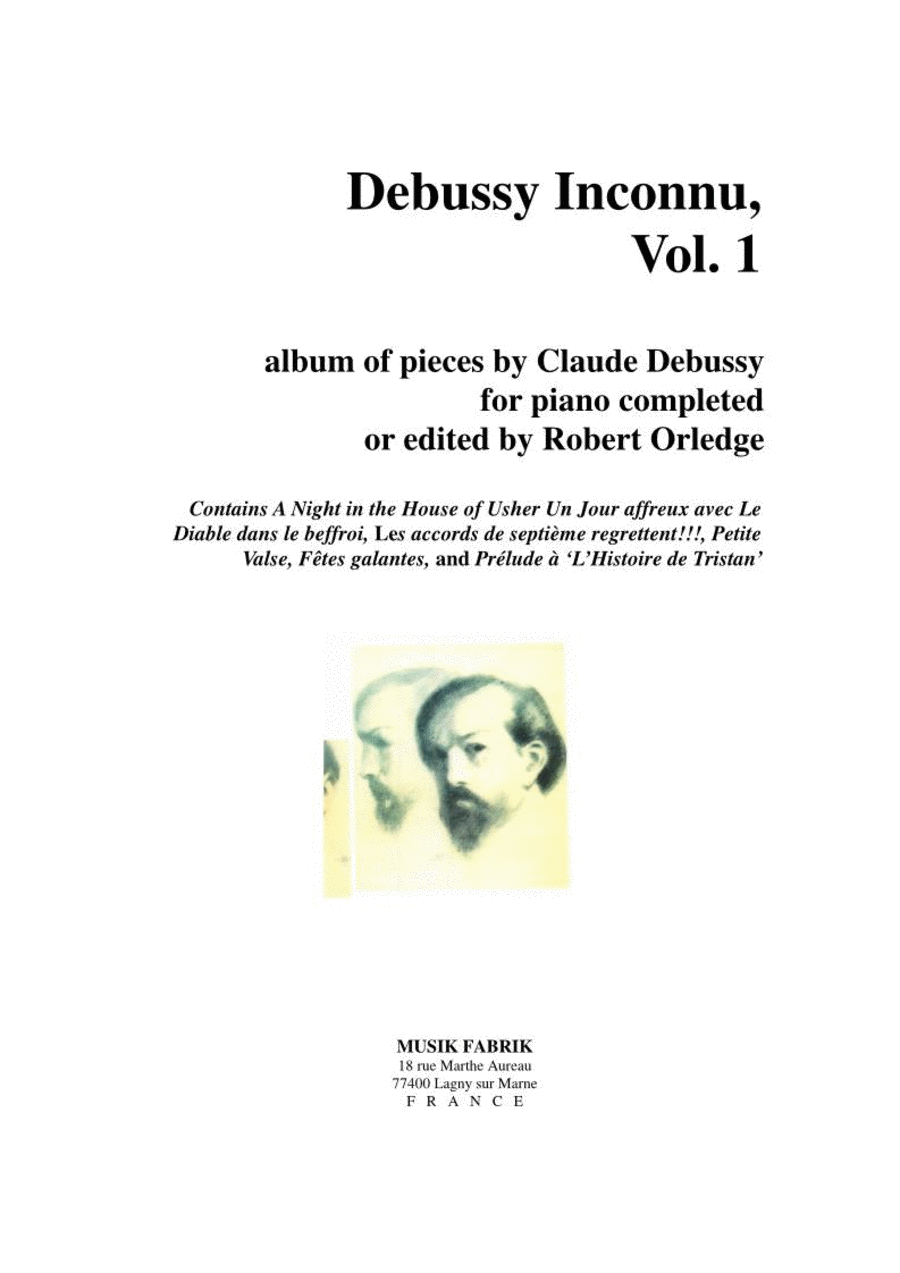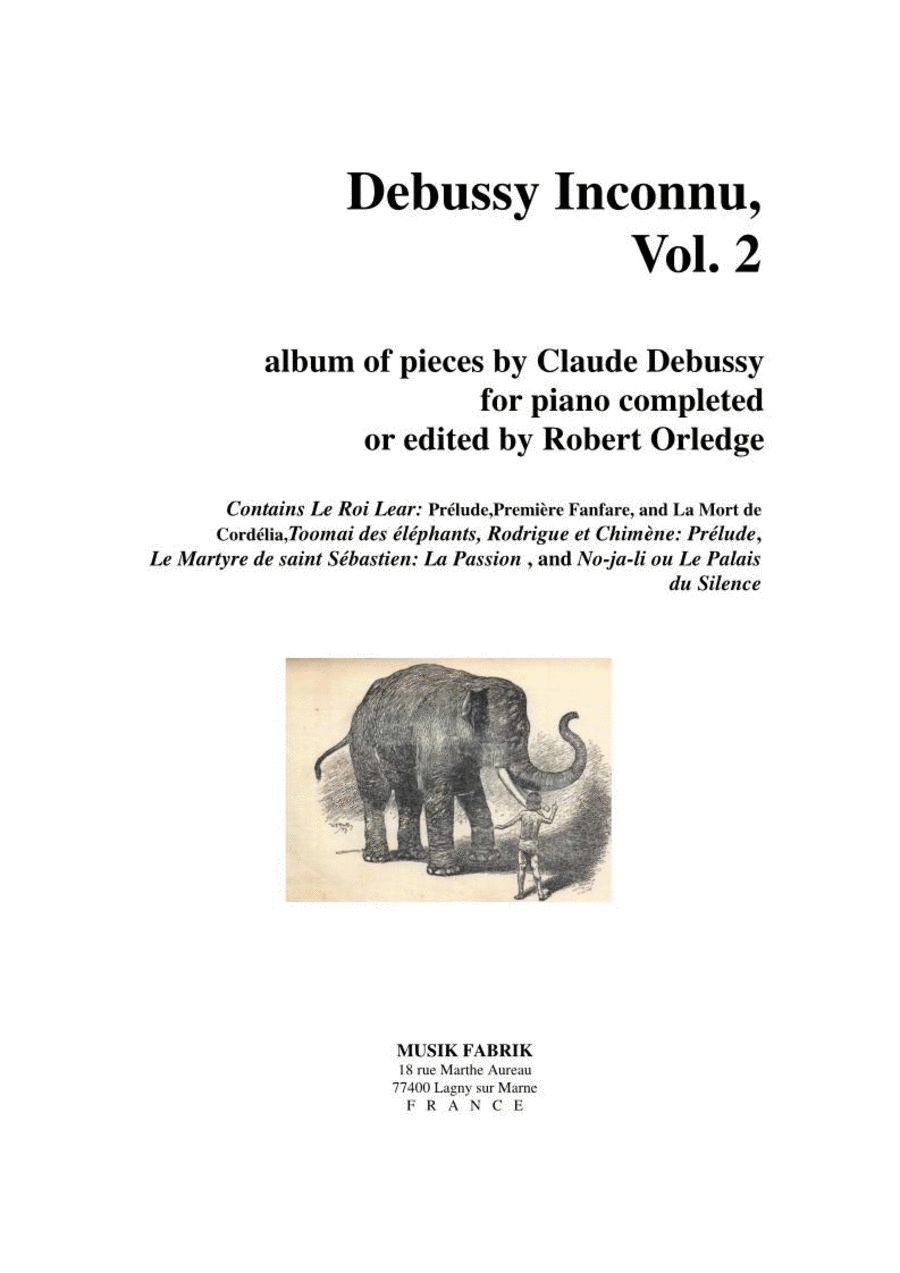 | By Nicolas Horvath. By
Robert Orledge and Claude
Debussy (1862-1918).
Rediscoverd Debussy.
Christmas. Score. Musik
Fabrik #MFCD017A. Published
by Musik Fabrik Arr : Piano soloPublisher : Musik Fabrik$48.69 - See more - Buy online
8.27 x 11.69 inches.
Contains A Night in the House of Usher Un Jour affreux avec Le Diable dans le beffroi, Les accords de septieme regrettent!!!, Petite Valse,Fetes galantes, and Prelude a 'L'Histoire de Tristan'
From Robert Orledge's notes:
My interest in the wonderful music of Claude Debussy began in the 1980s when I researched and published a book with Cambridge University Press entitled Debussy and the Theatre. During the course of my studies in Paris, I was amazed to discover that Debussy planned over 50 theatrical works but only finished two of these entirely by himself (the opera Pelleas et Melisande in 1893-1902 and the ballet Jeux for Diaghilev's Ballets Russes in 1912-13). Of the rest, many were never started musically (like Siddartha and Orphee-roi with the Oriental scholar Victor Segalen, 1907); some had a few tantalising sketches (like the Edgar Allan Poe opera Le Diable dans le beffroi, 1902-03); some were half-finished (like his other Poe opera La Chute de la Maison Usher, 1908-17); while others were musically complete but had their orchestrations completed by other composers (like Khamma, by Charles Koechlin, 1912-13; or Le Martyre de Saint Sebastien and La Boite a joujoux by his 'angel of corrections' ['l'ange des Corrections'] Andre Caplet in 1911 and 1919 respectively).
For it has to be admitted that what some scholars call Debussy's 'compulsive achievement' could equally well be viewed as laziness, especially as far as the minute detail required for calligraphing his orchestral scores was concerned. It was as if creating the music itself was of greater importance than controlling its final sound, even if Debussy was an imaginative orchestrator when he found the time and energy to do it. It also seems true that Debussy also preferred inventing ideas to turning them into complete pieces. However, despite the lack of detail in many of his sketches (missing clefs, key signatures, dynamics, phrasing, etc.) the notes themselves are surprisingly accurate, whether or not they can be compared with a later draft. Thus, a large number of sketches exist for his Chinese ballet No-ja-li ou Le Palais du Silence and it is not too difficult to see which parts of Georges de Feure's 1913 scenario (see below) inspired which ideas. But Debussy hardly made any attempt to join them together after the first few bars.
It was usually up to his publisher, Jacques Durand, to find solutions when Debussy risked a breach of contract. Debussy was supposed to supervise the orchestrations completed by others, but this supervision was usually very light and restricted to quiet, sensitive moments in which problems were easier to spot. Far from jealously guarding every one of his created notes, as Ravel did, Debussy once even went as far as to ask Koechlin to 'write a ballet for him that he would sign' on 26 March 1914 when he was hard-pressed to fulfil his lucrative contract for No-ja-li with Andre Charlot at the Alhambra Theatre in London. In the end, Debussy (through Durand) sent Charlot the symphonic suite Printemps instead, whose orchestration had been completed by Henri Busser in the Spring of 1912.
So, when I was offered early retirement as Professor of Music at Liverpool University in 2004, I seized the opportunity it would give me to spend time trying to reconstruct some of Debussy's lost potential masterpieces from his existing sketches and drafts--then orchestrating them in Debussy's style when this was appropriate. I had begun this mission in 2001 with the most promising project, the missing parts of Scene 2 of La Chute de la Maison Usher and the sheer joy it gave me at every stage persuaded me to tackle other projects, especially when Debussy experts were unable to identify exactly where I took over from Debussy (and vice versa) in Usher. |
|

 (AMERICAN COMPANY)
(AMERICAN COMPANY) 

